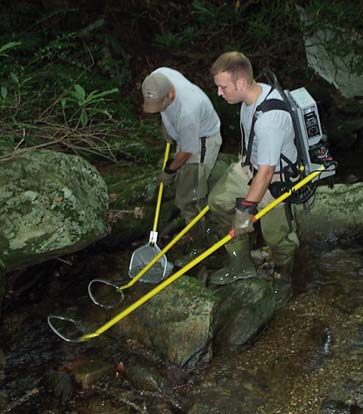State Freshwater Trout of North Carolina: Southern Appalachian Brook Trout
See also: North Carolina State Symbols and Official Adoptions main page
The General Assembly of 2005 named the Southern Appalachian Brook Trout as the official Freshwater Trout for the State of North Carolina (Session Laws, 2005, c. 387).
by Mark S. Davis, updated by Jacob Rash.
North Carolina Wildlife Resources Commission, 2010. PDF: https://www.ncwildlife.org/Portals/0/Fishing/documents/BrookTrout.pdf
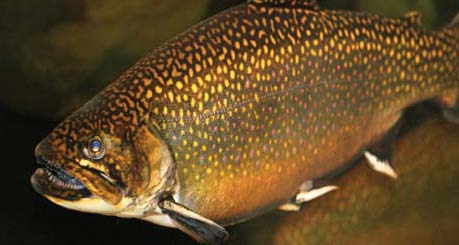 Classification
Classification
Class: Osteichthyes (bony fishes)
Order: Salmoniformes
Family: Salmonidae
Average Size
Length: 6 in. to 8 in.
Weight: 1/4 to 1/2 lbs.
Food
Adults eat a wide variety of aquatic and terrestrial insects, as well as crustaceans, fish and other small vertebrates, while young feed on small aquatic and terrestrial insects.
Spawning
Occurs in fall, generally September through November. Females will construct a nest (redd) in gravel, and incubation period varies depending upon water temperature.
Young
Called alevins. Remain in nest (redd) until yolk sac is absorbed, then emerge as free-swimming fry. Most reach sexual maturity at approximately two years
Life Expectancy
Generally short-lived, seldom longer than 4 years in the wild.
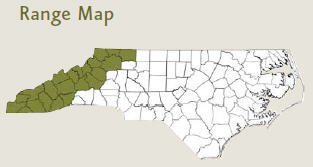 Range and Distribution
Range and Distribution
Wild brook trout are often restricted to small headwater streams in the mountains of North Carolina. Genetic studies indicate that brook trout native to North Carolina represent a unique strain called Southern Appalachian brook trout.
General Information
The brook trout is regarded as one of North America’s most beautiful native fish species. Here in North Carolina, local anglers often call them “specks,” “speckled trout,” or “brookies.” Recent genetic studies suggest that the native brook trout found in the southern Appalachians, including the mountains of western North Carolina, represent a unique strain called Southern Appalachian brook trout.
History and Status
The brook trout is the only trout native to western North Carolina. Several varieties of brook trout exist within its indigenous range from the mountains of Georgia to the coastal rivers of Canada. North Carolina mountain streams once teemed with Southern Appalachian brook trout (the strain of brook trout native to North Carolina) where abundant rainfall, cool climate, cold groundwater and dense forest cover provided optimum living conditions. In the late 1800s, logging companies began to cut the vast stands of virgin timber in the mountains of the state. Early logging practices included the construction of roads and rail lines up river valleys, intensive tree cuttings on steep slopes, and the usage of splash dams to transport logs downstream. These activities caused significant damage to stream habitats. Extensive erosion and siltation from land disturbing activities limited spawning success by smothering eggs and restricting their oxygen supply, and streams that historically supported coldwater fishes were warmed due to lost canopy cover.
Northern strain brook trout (from the northeastern U.S), rainbow trout (from the western U.S.) and brown trout (from Europe) were stocked around 1900 to replace brook trout populations lost due to logging operations. Resident brook trout were often unable to compete with rainbow and brown trout for available food, habitat and spawning sites within the altered landscape of the southeast. In addition, alterations to native brook trout population genetics have occurred due to interactions with Northern strain brook trout. With continued development of the mountain region and further encroachment on habitat by man and non-native species, the future of the wild brook trout is of concern, and since 1900, the brook trout range is thought to have declined by about 80 percent. State and federal agencies are developing strategies to identify, maintain and expand existing wild brook trout populations to ensure their survival in their native range.
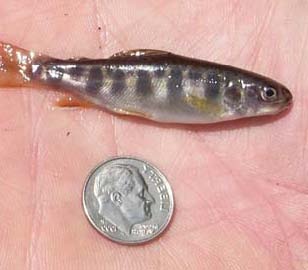 Description
Description
Brook trout can be distinguished by the olive-green coloration of the upper sides with mottled, dark green “worm-like” markings on their backs and tails. The lower sides are lighter with yellow spots interspersed with fewer spots of bright red surrounded by blue. The lower fins are orange with a narrow black band next to a leading white edge.
Habitat and Habits
Wild brook trout are most abundant in isolated, high-altitude headwater streams where the water is free of pollution and rich in oxygen. Brook trout prefer streams with stable water flows, silt-free gravel for spawning and an abundance of pools and riffles with sufficient in-stream cover, such as logs and boulders. Young brook trout feed on small aquatic and terrestrial insects. Adults eat a wide variety of aquatic and terrestrial insects, as well as crustaceans, fish and other small vertebrates.
Decreasing daylight and temperature associated with autumn signify the onset of spawning, which typically occurs between September and November. The female will construct a nest called a “redd” in the gravel substrate. The male courts the female and will chase away intruding males. Both fish then settle into the redd and release eggs (100 to 5,000 depending on the size of the female) and sperm (milt) simultaneously. Fertilized eggs are covered with gravel by the female and remain in the redd until they hatch in the early spring. Once free-swimming fry emerge from the redd it will take them approximately two years to become mature. Generally short-lived, brook trout seldom live longer than four years in the wild, and they rarely exceed ten inches in length.
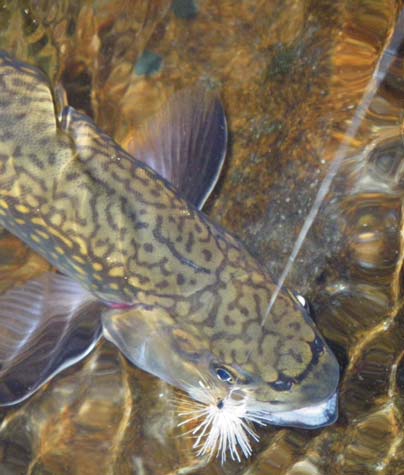 People Interactions
People Interactions
In North Carolina, brook trout are legally taken by hook-and-line sport fishing, and management is directed toward enhancing and protecting wild populations, while providing seasonal fisheries via stockings. Anglers prize brook trout for their delicate flesh and superior flavor, and also because of their willingness to take artificial and natural baits. Fishing dry flies, streamers and nymphs that imitate natural food items works well. This method is especially popular in North Carolina’s many streams that support wild trout. Fishing baits, such as worms and corn, work well for hatchery-reared brook trout. Spin casting small spinners, spoons and crankbaits can be productive as well. Check the current trout fishing regulations on the type of lures allowed as well as the size limit and creel limit for a particular trout water before fishing
NCWRC Interaction: How You Can Help
Work to protect brook trout habitat in North Carolina. Sediment is the number one source of pollution in the state and it is primary cause for the demise of brook trout populations across western North Carolina. By working to reduce erosion by stabilizing stream banks and by maintaining vegetated stream buffers, private land owners can do their part to help protect brook trout habitat. In the end, protection of brook trout habitat is the key to the perpetuation of the species.
References:
Carlander, Kenneth D. 1969. Handbook of freshwater fishery biology. Volume 1. Ames: Iowa State University Press.
Jenkins, Robert E., and Noel M. Burkhead. 1994. Freshwater fishes of Virginia. Bethesda, Md: American Fisheries Society.
Manooch, Charles S., and Duane Raver. 1984. Fisherman's guide: fishes of the Southeastern United States. Raleigh, N.C.: North Carolina State Museum of Natural History.
McClane, A. J. 1998. McClane's new standard fishing encyclopedia and international angling guide. New York: Gramercy Books.
Brook trout profile (from FishBase)
Conserving the Eastern Brook Trout (from the Eastern Brook Trout Joint Venture)
Resources in Worldcat
Credits:
Illustrated by J.T. Newman. Produced by the Division of Conservation Education, Cay Cross–Editor.

1 June 2007 | Davis, Mark
